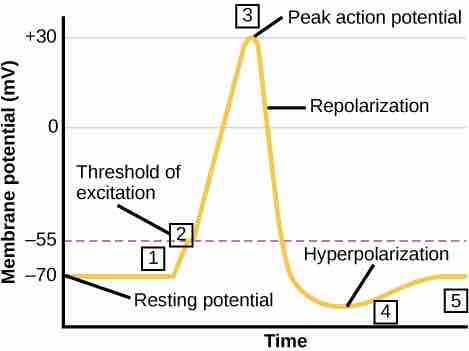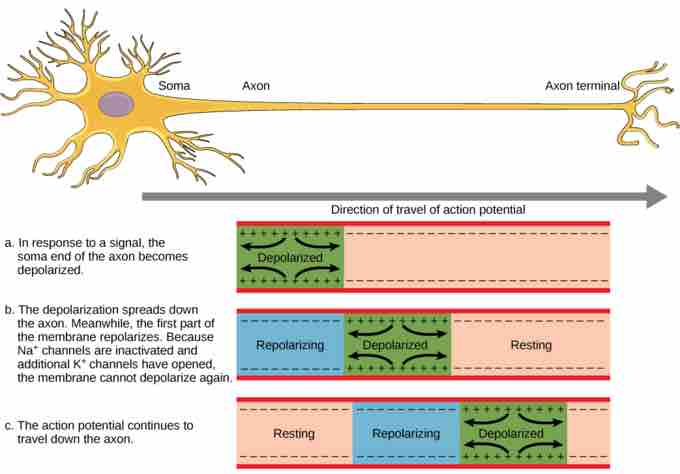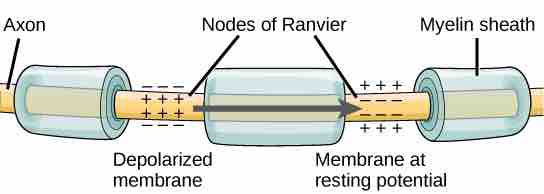Action Potential
A neuron can receive input from other neurons via a chemical called a neurotransmitter. If this input is strong enough, the neuron will pass the signal to downstream neurons. Transmission of a signal within a neuron (in one direction only, from dendrite to axon terminal) is carried out by the opening and closing of voltage-gated ion channels, which cause a brief reversal of the resting membrane potential to create an action potential . As an action potential travels down the axon, the polarity changes across the membrane. Once the signal reaches the axon terminal, it stimulates other neurons.

Formation of an action potential
The formation of an action potential can be divided into five steps. (1) A stimulus from a sensory cell or another neuron causes the target cell to depolarize toward the threshold potential. (2) If the threshold of excitation is reached, all Na+ channels open and the membrane depolarizes. (3) At the peak action potential, K+ channels open and K+ begins to leave the cell. At the same time, Na+ channels close. (4) The membrane becomes hyperpolarized as K+ ions continue to leave the cell. The hyperpolarized membrane is in a refractory period and cannot fire. (5) The K+ channels close and the Na+/K+ transporter restores the resting potential.
Depolarization and the Action Potential
When neurotransmitter molecules bind to receptors located on a neuron's dendrites, voltage-gated ion channels open. At excitatory synapses, positive ions flood the interior of the neuron and depolarize the membrane, decreasing the difference in voltage between the inside and outside of the neuron. A stimulus from a sensory cell or another neuron depolarizes the target neuron to its threshold potential (-55 mV), and Na+ channels in the axon hillock open, starting an action potential. Once the sodium channels open, the neuron completely depolarizes to a membrane potential of about +40 mV. The action potential travels down the neuron as Na+ channels open.
Hyperpolarization and Return to Resting Potential
Action potentials are considered an "all-or nothing" event. Once the threshold potential is reached, the neuron completely depolarizes. As soon as depolarization is complete, the cell "resets" its membrane voltage back to the resting potential. The Na+ channels close, beginning the neuron's refractory period. At the same time, voltage-gated K+ channels open, allowing K+ to leave the cell. As K+ ions leave the cell, the membrane potential once again becomes negative. The diffusion of K+ out of the cell hyperpolarizes the cell, making the membrane potential more negative than the cell's normal resting potential. At this point, the sodium channels return to their resting state, ready to open again if the membrane potential again exceeds the threshold potential. Eventually, the extra K+ ions diffuse out of the cell through the potassium leakage channels, bringing the cell from its hyperpolarized state back to its resting membrane potential.
Myelin and Propagation of the Action Potential
For an action potential to communicate information to another neuron, it must travel along the axon and reach the axon terminals where it can initiate neurotransmitter release . The speed of conduction of an action potential along an axon is influenced by both the diameter of the axon and the axon's resistance to current leak. Myelin acts as an insulator that prevents current from leaving the axon, increasing the speed of action potential conduction. Diseases like multiple sclerosis cause degeneration of the myelin, which slows action potential conduction because axon areas are no longer insulated so the current leaks.

Action potential travel along a neuronal axon
The action potential is conducted down the axon as the axon membrane depolarizes, then repolarizes.
A node of Ranvier is a natural gap in the myelin sheath along the axon . These unmyelinated spaces are about one micrometer long and contain voltage gated Na+ and K+ channels. The flow of ions through these channels, particularly the Na+ channels, regenerates the action potential over and over again along the axon. Action potential "jumps" from one node to the next in saltatory conduction. If nodes of Ranvier were not present along an axon, the action potential would propagate very slowly; Na+ and K+ channels would have to continuously regenerate action potentials at every point along the axon. Nodes of Ranvier also save energy for the neuron since the channels only need to be present at the nodes and not along the entire axon.

Nodes of Ranvier
Nodes of Ranvier are gaps in myelin coverage along axons. Nodes contain voltage-gated K+ and Na+ channels. Action potentials travel down the axon by jumping from one node to the next.